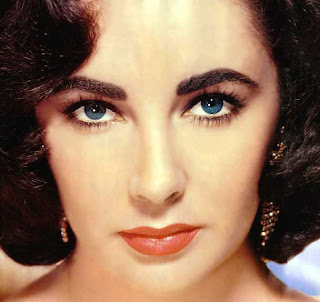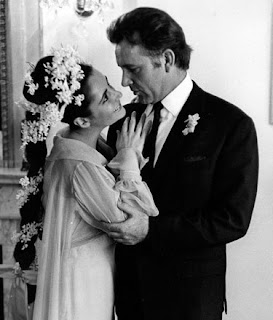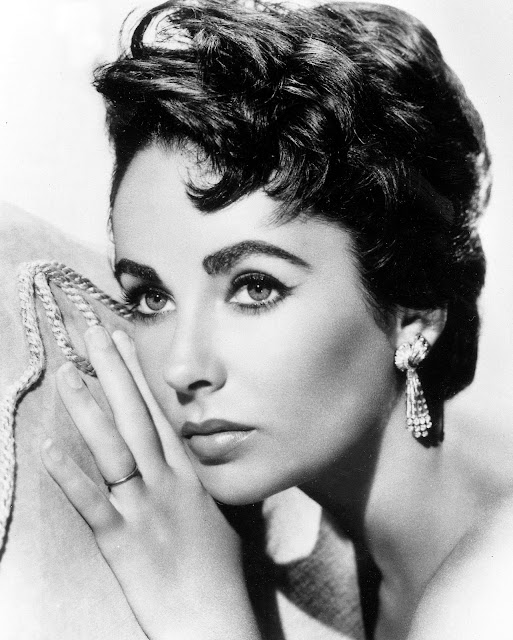
Revered for her generous charity work but sometimes controversial for her turbulent personal life, the three-time Oscar honoree, fragrance and jewelry mogul and tenacious AIDS activist possessed many talents, including a remarkable gift for self-appraisal.
Just before turning 60 in 1992, she summed herself up for Life magazine, saying: "I've been lucky all my life. Everything was handed to me: looks, fame, wealth, honors, love. But I've paid for that luck with disasters. Terrible illnesses, destructive addictions, broken marriages."
 |
| With Richard Burton |
Timid Father, Pushy Mother
Born in Hampstead, England, the second child of Francis Taylor, a timid American art gallery owner working abroad, and his highly assertive wife Sara Sothern, a former actress, Elizabeth Rosemond Taylor moved with her family to Los Angeles in 1939.
Pushed by Sara, young Elizabeth made her movie debut in 1942's There's One Born Every Minute, and appeared with lifelong friend Roddy McDowall in 1943's Lassie Come Home. But it was 1944's National Velvet, with Mickey Rooney, that brought her stardom at age 12. Not only was she a natural before the camera, but also, even then, Technicolor – and movie audiences – just couldn't get enough of her remarkable violet-colored eyes.
A string of movies followed (such as 1946's Courage of Lassie and 1949's Little Women), but critics still were not impressed – a fact she would have to contend with to varying degrees throughout her career. (Taylor once told Johnny Carson that she'd been given a preview of some of her obituaries, "and they were the best reviews I'd ever gotten.")
 |
| With Paul Newman |
With her showy role opposite Rock Hudson and James Dean in 1956's Giant, the then-23-year-old Taylor cemented her place as an actress, and went on to be nominated for an Oscar three years in a row – 1958, 1959 and 1960 – before winning her first Academy Award in 1961 (for Butterfield 8). She would take home another in 1967, for her blowsy role as the drunken and unsatisfied wife in Who's Afraid of Virginia Woolf?, and a third, a special humanitarian award, in 1993.
But for all the attention Taylor earned for her onscreen life, it was her personal dramas that kept her in the public eye nearly all the time.

She followed the failed union with a brief affair with film director Stanley Donen (Singin' in the Rain). Shortly afterward, while in England filming Ivanhoe, Taylor met British actor Michael Wilding, and the pair wed in February 1952. "It's leap year, so I leapt!" Taylor told reporters at the time. That union lasted five years and produced two sons, Michael and Christopher.
Close Call to Tragedy
Her next marriage was to producer Mike Todd (Around the World in 80 Days). Of Todd, Taylor wrote in Elizabeth Takes Off: "He was 25 years my senior and eternally young. I could hardly keep up with him. He was the most energetic man I've ever known, and he made our short 18 months together one of the most intensely glorious times of my life." Todd died a year after their wedding when his plane crashed, leaving his widow with their 7-month-old daughter, Liza. Taylor had been scheduled to travel with him, but she stayed behind with the flu.

The Battling Burtons
Though some have speculated that Todd might have been her last husband had he lived, Taylor's most famous union was inarguably with Burton. Their first marriage, in 1964 (nine days after her divorce from Fisher became final), would last 10 years, a record for Taylor. They made 11 movies together, from the sublime (1966's Oscar-winning Who's Afraid of Virginia Woolf?) to the ridiculous (1968's Boom!), and generated countless headlines with their lavish lifestyle, including his gifts to her of the 33.19-carat Krupp diamond and the 69.42-carat Taylor-Burton diamond.
 |
| With Richard Burton |
Still seeking the perfect off-screen role, Taylor retired from acting in 1976 to marry John Warner, a Republican from Virginia who was running for the Senate. But the couple seemed a mismatch from the start. He was conservative; she, anything but. And while Taylor was vivacious and social, Warner was all work.
The marriage took its physical toll on the onetime beauty, too: Left alone on the couple's Virginia estate while her husband tended to congressional business, Taylor found herself in what she called "a domestic Siberia," and, lonely and unhappy, she gained more than 60 lbs. She shed much of the weight at health spas in time to make her Broadway debut in Lillian Hellman's play The Little Foxes in 1981, but the marriage ended soon after.
Then, in 1983, things took a sharp turn for the worse. Taylor had moved to Los Angeles and performed in the play Private Lives with Burton, and the strain of that experience caused her to fall back into old excesses. "I began to crack," Taylor recalled in her autobiography. "My worst habits surfaced. I began overeating, drinking and taking pills." On Dec. 5, Taylor entered the Betty Ford Clinic in Rancho Mirage, Calif. "A family intervention took place," Taylor wrote. "My children, my brother, a few intimate friends made me face the facts."

Taylor overcame her addictions for a time, but during a return visit to the clinic in 1988 to battle a drug dependency, Taylor met her seventh (and final) husband, construction worker Larry Fortensky, whom she married in 1991 and divorced in 1996. At the time, Taylor vowed to PEOPLE that she would never marry again. "You don't get over men like the flu," she said at the time. "Every divorce is like a little death."
Still, if the legacy that Taylor leaves began with the first of her more than 50 movie performances and endured during her battles with ill health (she had nearly 40 surgeries, ranging from hip replacements to the removal of a brain tumor) and multiple divorces, it was cemented by her extraordinary contributions as a humanitarian and activist.
 |
| With Rock Hudson |
The Elizabeth Taylor AIDS Foundation, formed in 1991, has has also distributed millions of dollars to AIDS organizations internationally. For her humanitarian work, Taylor was made a Dame Commander of the British Empire by Queen Elizabeth II in 1999, causing the star to wisecrack: "I've always been a broad, now I'm a dame." In 2001, President Bill Clinton awarded her the Presidential Citizens Medal in recognition of her commitment to philanthropy.

And though, save for an occasional Larry King interview – and to Tweet her recent hospital visit as involving "repairing my leaky valve using a clip device, without open heart surgery, so that my heart will function better" – she mostly withdrew from the public spotlight in recent years, Elizabeth Taylor remained a presence, a talent that is not likely to escape her, even in death.
------------
Source: http://www.people.com/people/article/0,,880081,00.html


No comments:
Post a Comment